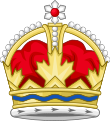
Back دستور كندا Arabic Verfassung von Kanada German Konstitucio de Kanado Esperanto Constitución de Canadá Spanish قانون اساسی کانادا Persian Kanadan perustuslaki Finnish Constitution du Canada French חוקת קנדה HE Kanada alkotmánya Hungarian Costituzione del Canada Italian
| Part of a series on the |
| Constitution of Canada |
|---|
 |
|
|
| Part of a series on |
| Canadian law |
|---|
 |
 |
|---|
The Constitution of Canada (French: Constitution du Canada) is the supreme law in Canada.[1] It outlines Canada's system of government and the civil and human rights of those who are citizens of Canada and non-citizens in Canada.[2] Its contents are an amalgamation of various codified acts, treaties between the Crown and Indigenous Peoples (both historical and modern), uncodified traditions and conventions. Canada is one of the oldest constitutional monarchies in the world.[3]
The Canadian constitution includes core written documents and provisions that are constitutionally entrenched, take precedence over all other laws and place substantive limits on government action; these include the Constitution Act, 1867 (formerly the British North America Act, 1867) and the Canadian Charter of Rights and Freedoms.[4] The Constitution Act, 1867 provides for a constitution "similar in principle" to the largely unwritten constitution of the United Kingdom, recognizes Canada as a constitutional monarchy and federal state, and outlines the legal foundations of Canadian federalism.[5]
The Constitution of Canada includes written and unwritten components.[4] Section 52 of the Constitution Act, 1982 states that "the Constitution of Canada is the supreme law of Canada" and that any inconsistent law is of no force or effect.[4] It further lists written documents which are included in the Constitution of Canada; these are the Canada Act 1982 (which includes the Constitution Act, 1982), the acts and orders referred to in its schedule (including in particular the Constitution Act, 1867), and any amendments to these documents.[6]
The Supreme Court of Canada has held that this list is not exhaustive and that the Constitution of Canada includes a number of pre-confederation acts and unwritten components as well.[7][8] The Canadian constitution also includes the fundamental principles of federalism, democracy, constitutionalism and the rule of law, and respect for minorities.[8] See list of Canadian constitutional documents for details.
- ^ Supreme Court of Canada; Public Works and Government Services Canada (November 1, 2000). The Supreme Court of Canada and its Justices 1875-2000: La Cour suprême du Canada et ses juges 1875-2000. Dundurn. pp. 27–. ISBN 978-1-77070-095-6.
- ^ Patrick Malcolmson; Richard Myers; Gerald Baier; Tom Bateman (2016). The Canadian Regime: An Introduction to Parliamentary Government in Canada, Sixth Edition. University of Toronto Press. pp. 75–76. ISBN 978-1-4426-3598-2.
- ^ John Courtney. David Smith (2010). The Oxford Handbook of Canadian Politics. Oxford University press. p. 21. ISBN 978-0-19-533535-4.
- ^ a b c Monahan, Patrick J.; Shaw, Byron; Ryan, Padraic (2017). Constitutional Law (5th ed.). Toronto, ON: Irwin Law Inc. pp.3-9. ISBN 978-1-55221-587-6
- ^ Monahan, Patrick J.; Shaw, Byron; Ryan, Padraic (2017). Constitutional Law (5th ed.). Toronto, ON: Irwin Law Inc. pp. 52-54. ISBN 978-1-55221-587-6
- ^ Christopher Dunn (2015). Provinces: Canadian Provincial Politics, Third Edition. University of Toronto Press. p. 297. ISBN 978-1-4426-3399-5.
- ^ Adam Dodek (2016). The Canadian Constitution. Dundurn - University of Ottawa Faculty of Law. p. 13. ISBN 978-1-4597-3505-7.
- ^ a b Monahan, Patrick J.; Shaw, Byron; Ryan, Padraic (2017). Constitutional Law (5th ed.). Toronto, ON: Irwin Law Inc. pp.7-8. ISBN 978-1-55221-587-6